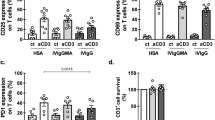Abstract
The effects of rhG-CSF on lymphocyte blastogenesis were evaluated in six healthy donors, submitted to progenitor cell mobilization for allogeneic transplantation. Neutrophil, monocyte and lymphocyte count increased 6.7-fold, 5.3-fold and 2.0-fold on day +4 of rhG-CSF as compared with baseline. The DNA stimulation index (DNA SI) of 72 h phytohemagglutinin (PHA)-treated cultures decreased from 20% (15–35.5) prior to rhG-CSF to 6.7% (1.5–11.9; P = 0.0026), 8% (4–12; P = 0.0091) and 15% (9–22; P = 0.0091) on days +2, +4 and +6; similarily, reactivity to concanavalin A decreased from 18% (12–20) to 1.8% (0.5–7; P < 0.01), 3% (2–8; P < 0.01) and 5% (2–11; P = 0.009). No changes of lymphocyte response to pokeweed mitogen were observed. DNA SI of PHA-treated cultures inversely correlated with neutrophil and monocyte count. IL-1 receptor antagonist (IL-1ra) and lactoferrin (Lf) plasma levels sharply increased and correlated with neutrophil and monocyte count. IL-10 increased five-fold on day +2, returned to pretreatment values thereafter and did not show any correlation with DNA SI, suggesting that it was not responsible for the observed phenomena. Interestingly, DNA SI of PHA-treated cultures inversely correlated with IL-1ra and Lf levels. CD3+ and CD19+ lymphocyte activation status, ie CD23, CD25, CD30 and HLA-DR coexpression, was not affected by rhG-CSF administration. Pharmacological doses of rhG-CSF in healthy donors inhibit lymphocyte blastogenesis via an increased production and/or release of immunoregulatory soluble mediators, ie IL-1ra and Lf, by primed neutrophils and monocytes.
This is a preview of subscription content, access via your institution
Access options
Subscribe to this journal
Receive 12 print issues and online access
$259.00 per year
only $21.58 per issue
Buy this article
- Purchase on Springer Link
- Instant access to full article PDF
Prices may be subject to local taxes which are calculated during checkout
Similar content being viewed by others
Author information
Authors and Affiliations
Rights and permissions
About this article
Cite this article
Rutella, S., Rumi, C., Testa, U. et al. Inhibition of lymphocyte blastogenic response in healthy donors treated with recombinant human granulocyte colony-stimulating factor (rhG-CSF): possible role of lactoferrin and interleukin-1 receptor antagonist. Bone Marrow Transplant 20, 355–364 (1997). https://doi.org/10.1038/sj.bmt.1700899
Received:
Accepted:
Issue Date:
DOI: https://doi.org/10.1038/sj.bmt.1700899
Keywords
This article is cited by
-
Granulocyte transfusions in children and adults with hematological malignancies: benefits and controversies
Journal of Translational Medicine (2015)



